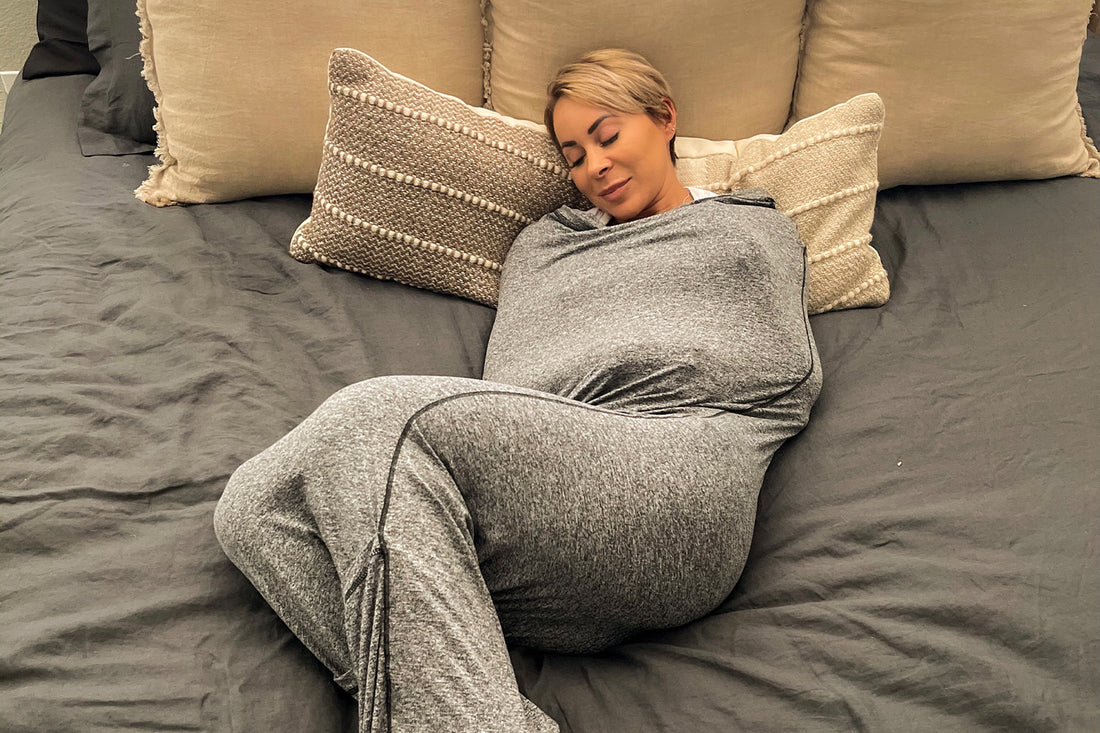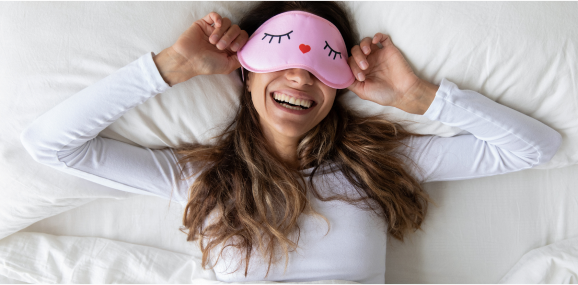Approximately 2% of adults report experiencing night terrors, but that number can be much higher. Since many people don’t remember their night terrors, it’s possible that people who sleep alone or have a partner who is a heavy sleeper may not be acutely aware of night terror activity.
If you know you’re experiencing night terrors, here’s what you need to understand about the situation and what you can do to address the underlying cause.
What Are Night Terrors?
Night terrors are a parasomnia. Any behavior or involuntary action that occurs during sleep, such as sleepwalking or sleep talking, is considered a parasomnia behavior. Where something like sleep talking is relatively benign, night terrors have the potential to be very emotionally distressing.
When you’re asleep, your brain produces a special chemical called GABA that dulls your response to arousal. This chemical plays a key role in helping your body to fall asleep, and without GABA, you’re more likely to have trouble dozing off.
When your body produces adequate GABA, you’re less likely to be aware of noises at a low volume or small movements your partner may make beside you. GABA helps you to enter REM sleep. When you enter REM sleep, your brain naturally and mildly paralyzes your muscles to keep you from moving while you dream.
Sometimes, there’s a disruption in this process or it doesn’t work effectively. This can lead to people moving in their sleep. This happens to everyone occasionally, and it usually isn’t cause for concern. It only becomes troubling if it escalates past the point of infrequent light movement to full-fledged movement.
Night terrors are episodes of the body involuntarily acting out behaviors associated with intense fear while someone is still asleep. Some people with night terrors scream or yell. Others act as though they’re attempting to fight or protect themselves. In severe cases, people with night terrors can sleepwalk in an attempt to run away.
Some night terrors only last a few seconds. Many people don’t remember short night terrors. Some night terrors can last up to several minutes, which is when many people notice that night terrors are becoming a profound disturbance in their sleep habits.
Night terrors themselves are emotionally distressing. They can become dangerous if someone sleepwalks or heavily flails, which can cause them to injure themselves or someone else when acting out their dreams.
What’s the Difference Between Night Terrors, Nightmares, and Sleep Paralysis?
Although these terms are sometimes used interchangeably, they refer to three completely different parasomnias. A nightmare is a bad dream which you don’t act out, and sleep paralysis is the inability to move before entering a state of wakefulness.
What is a Nightmare?
A nightmare is simply a bad dream, and most people will have nightmares from time to time. Because the body is in a properly functioning sleep state, you won’t act out your nightmare. That’s the difference between a night terror and a nightmare. Nightmares can also be emotionally distressing and may require intervention if they occur frequently.
What is Sleep Paralysis?
Sleep paralysis is the opposite of a night terror. Rather than acting out a dream, people with sleep paralysis find that their brain begins to wake up before their body stops sending signals to keep their muscles from moving. They attempt to move, but find that they’re unable to do so until their brain and body regulate communication.
Some people in sleep paralysis experience a nightmare-like state. They aren’t fully awake, but they’re not fully asleep. It can be difficult to separate dream elements from reality, which can escalate a sense of panic or distress.
It’s not unusual for people to experience brief bouts of sleep paralysis a handful of times in their lives. Sleep paralysis requires intervention by a sleep specialist or a doctor if it occurs frequently.
How To Tell If You or Someone Else Is Having a Night Terror
Night terrors are expressions of fear, and everyone acts differently when they’re afraid. Night terrors can manifest in many ways. If you’re the one having the night terror, it’s easier for you to interpret your own feelings.
If you believe someone else is having a night terror, there may be a few obvious signs.
- Shouting or screaming
- Flailing, trashing, or motions similar to fighting
- Aggression or confusion when someone attempts to intervene
- Rapid heart rate and breathing
- Sweating or panting
- Jitteriness or shakiness, similar to a panic attack
- Attempting to run, move, or flee
Some people may have subtle night terrors. They may cry, whimper, or recoil. These night terrors can be more difficult to pinpoint.
What Causes Night Terrors in Adults?
There is no definitive cause for night terrors, which means they cannot be directly treated.
Some underlying mental or physical health conditions, as well as difficult life situations, may contribute to the frequency of night terrors. Addressing these causes may reduce the prevalence of night terrors or cause them to stop completely.
Mental Health Conditions
Many mental health conditions can contribute to the frequency of nightmares, and nightmares have the potential to become night terrors.
- Depression
- Anxiety
- Post Traumatic Stress Disorder
- Bipolar Disorder
There is also a diagnosis of nightmare disorder, a condition in which people have frequent recurring nightmares with no identifiable underlying cause.
All of these mental health conditions require appropriate intervention, and each person’s path to relief will be different.
Talk therapy, psychology, behavioral therapy, and sometimes medications are necessary to help people manage the severity of these conditions. If you’re living with one of these conditions, you need to speak with a mental health professional. If you’re already under a professional’s care, it’s imperative to mention that you believe you’re having night terrors.
Issues With Breathing During Sleep
There may be a connection between sleep apnea and night terrors. Respiratory disorders that cause disruption in sleep can hinder your body’s ability to keep you still at night. Changes in respiration during sleep can also cause the body to experience feelings of panic, and these feelings can also contribute to night terrors.
You need to speak to your doctor if you believe you may be having difficulty breathing while you’re asleep. Your doctor may prescribe special equipment like a CPAP machine and may recommend lifestyle changes or a change in sleeping positions to minimize the stress on your respiratory system.
An Unusual Amount of Stress or a Recent Trauma
If you’ve recently endured a traumatic event or if your stress levels are higher than normal, this can have a negative impact on the way you sleep. Reducing the amount of stress in your life can help to resolve emotional unease.
If you’ve recently endured a traumatic event, reach out to a qualified professional who can help. You should also check your local area for relevant support groups if you believe you might benefit from the empathy of your community.
In the interim, practices like mindfulness meditation and journaling can help you find a positive outlet for any effects of emotional distress you may be experiencing.
How To Stop Night Terrors in Adults
Treating the underlying causes contributing to night terrors will likely have a positive effect on the frequency, severity, and duration of night terrors. Your doctor may recommend solutions or suggest a sleep study to observe your behavior.
In many cases, the person you share a bed with can provide valuable information to your doctor. If they’ve observed the episodes, they’ll be able to recall in greater detail the way you reacted during your night terror. Bring them to your appointment or put them on the phone with your doctor and allow them to describe what they’ve witnessed. They’re the most reliable narrator of your story, as you’re unlikely to remember most or any of what happened during your night terror.
You should always follow your doctor’s guidance and suggestions, see specialists when necessary, and complete any follow up instructions your doctor gives you.
Although there is no definitive cause or cure for night terrors, experienced medical professionals will be able to provide you with tailored guidance and discover medical or mental health issues that exacerbate the situation.
How To Make Bed a Relaxing Place
Since night terrors may correlate to emotional distress or anxiety, working to reduce these feelings is a great way to reduce the potential for night terrors. It’s a great idea for anyone to reduce these feelings in their life, whether or not they experience night terrors.
Reducing stress levels and improving your quality of sleep are necessary for your overall health and wellbeing. These are changes you can implement to make bedtime less stressful and more comfortable.
Keep Your Room as Comfortable as Possible
If your bed isn’t comfortable, you aren’t going to be comfortable. It’s worth ditching your old, lumpy mattress in favor of a mattress that provides you with adequate support. If your mattress isn’t old or in bad shape, special mattress toppers are a less expensive solution that can modify the way your bed supports you while you sleep.
Make sure the pillow you’re using is suited to your sleeping position. Back sleepers and side sleepers have their necks and spines in different positions throughout the night. The pillow you use should be designed to provide adequate support to your neck and spine in your preferred sleeping position.
Lastly, temperature is extremely important to your comfort when you sleep. You know what it feels like to sleep when it’s hot. You kick the covers off, sweat, toss, and turn all night. Choose bedding that’s breathable and appropriate for the season.
Keep your room between 60 degrees and 67 degrees Fahrenheit when you sleep. Research shows that this temperature range is optimal to promote restful sleep. Set your thermostat or air conditioner. If you have a smart thermostat, you can even program it to bring the temperature up an hour or two before you’re going to wake up. This will help you fight the urge to snuggle up under the warm covers and hit snooze.
Use a Hug Sleep Pod
Deep pressure therapy is a management tool that helps people feel more secure and relaxed. In a lot of ways, deep touch is like a hug that envelops your whole body. The Hug Sleep Pod is designed to replicate the principles of deep pressure therapy.
The Sleep Pod is made of a soft, breathable material that stretches in all four directions. You put your whole body in the pod, get comfortable, and let the gentle compression hug you. The pod holds you snug inside while you sleep, continuously applying just enough pressure to make you feel safe and secure.
Prioritize Your Mental Health
You need to make sure you’re doing well as a whole. You’re responsible for taking care of yourself, and you’re worth the effort.
Start journaling. Go for peaceful evening walks. Eat food that properly fuels your body. Talk to someone about your concerns. Telemedicine has made speaking with a mental health professional easier and more affordable than ever before.
Eliminate Possible Stressors
Don’t let yourself go to bed in a scared, sad, or anxious mood. Limiting your screen time can help with that. Screens emit blue light that can disturb your body’s natural clock, called your circadian rhythm. When your circadian rhythm detects blue light, it may believe it’s still daytime. This can lead to a delay in the production of melatonin, the hormone your body produces to get you ready for sleep.
Stay away from screens for at least two hours before bedtime. You don’t want to watch a movie or show that could scare or upset you. You don’t want to scroll through social media and stumble upon posts that make you anxious or fearful.
Before bed, give yourself a positive and peaceful unplugged activity to enjoy. Some people knit, draw, color, or paint. Reading an inspirational book may give you a few positive things to contemplate before you go to sleep. Yoga and mindfulness meditation can help you wipe your mental slate clean from the stresses of your day and allow you to lay a clearer head down on your pillow.
Focus on Feeling Secure at Bedtime
If you startle easily or if you live in a place where it gets a little noisy at night, white noise can help to drown out noise pollution. Some people use white noise machines. Other people find that a box fan generates enough white noise while helping cool air circulate throughout the room.
Make sure your doors are locked, your alarm is set, and your morning routine is set up. You won’t lay in bed wondering if you forgot something if you have a nightly checklist that you can run through. You can make your rounds before bed and assure that everything is done.
Conclusion
Although much about night terrors in adults still remains a mystery, there are strategies and approaches to reduce their frequency.
If you’re experiencing night terrors, speak to your doctor. Improving your bedtime routine can be a valuable coping strategy for reducing sleep anxiety and making you feel secure in the emantime.
Sources
Parasomnias | National Institutes of Health
Sleep terrors (night terrors) - Symptoms and causes | Mayo Clinic

































500,000+ happy customers